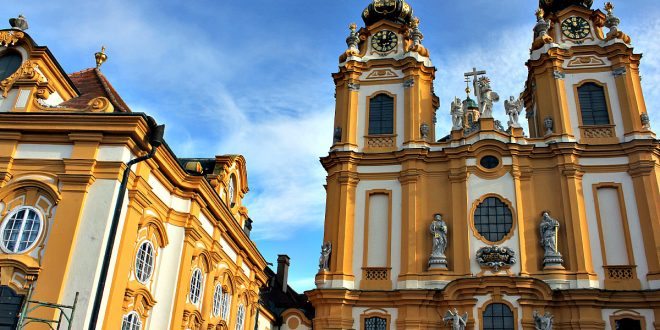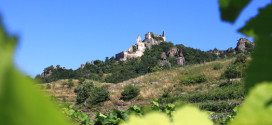Surely it’s easy to skip UNESCO World Heritage Site Melk Abbey. However, there is little reason you should. Unless you have set all your heart on Bauhaus architecture, learn what fans of classical culture are dying to see.
How Far Is Melk Abbey From Vienna?
Melk Abbey is a 75 minutes drive west of Vienna, in the Danube Valley of Wachau. By train, the direct ride from Vienna Western Train Station (Wien Westbahnhof) to Melk Train Station takes exactly one hour. Along with other local attractions, this makes a visit of the baroque monastery an easy day trip from Vienna.
Melk Abbey Facts
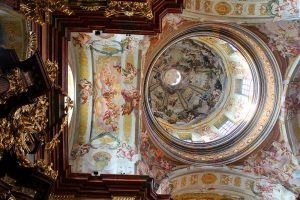
Towering above the Danube, the Benedictine monastery sits enthroned along one of Europe’s ancient trading routes in Wachau Valley. This part of the Danube lines up medieval villages, ruins and castles, apart from terraced vineyards producing award-winning Austrian white wines.
At more than 1,000 years of age Melk abbey is almost as old as Austria itself: Since 1,089, Benedictine monks have been living in Melk. Though until the 18th century, Melk was an unpretentious fortress. Between 1702 and 1746 abbot Berthold Dietmayer managed the abbey’s complete baroque refurbishment based on designs of Austrian baroque architect and stonemason Jakob Prandtauer. Today the abbey counts 497 rooms and a world class library counting 1,800 hand written books.
Today, about 40 monks still live and work at Melk Abbey. Apart from pastoral care, many of them teach at the onsite abbey school, which exists since 1160. With 900 secondary school pupils, Melk runs the largest private Catholic school in Austria.
What To See At Melk Abbey
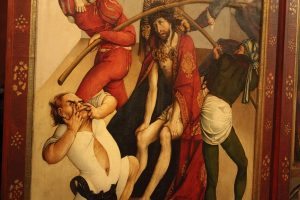
‘The Benedictines’ lifestyle is ascetic. But living in this splendour has to lift their spirits’. You can’t help pondering about the monks’ extraordinary housing: onion-domed towers, baroque sculptures, gold-plated wood carvings, fine marble columns, a library packed with precious leather-bound volumes, the spectacular view across the Danube.
We did a guided tour through the monastery’s museum, the church, the marble hall and the library. In the winter, you can only visit Melk Abbey through a guided tour, whereas in the summer you have the option of exploring it on your own. Without the guide I would have scratched the surface of this place. But what’s almost as amazing as the architecture is the role the abbey has played as a spiritual centre in old Europe.
There are more than two dozen Benedictine monks at Melk, a few hundred children who attend the abbey’s secondary school, and regular classical concerts open to the public.
It was curious how much Melk Abbey evoked Umberto Eco’s The Name Of The Rose during my visit. (Remember Adson of Melk, the young monk who narrates the story?)
The Library
Most visitors flock to the main library, world famous for its 16,000 ancient books (many of them a good 500 years old), awe-inspiring ceiling fresco in vibrant colours with white stucco, and richly decorated galleries and bookshelves. All that glamour to store books makes it obvious how precious knowledge was for the monks. The library is still in use, as a few gaps in the bookshelves showed. Behind the Main Library is the Small Library. Take a look at the delicate spiral staircase in rococo style.
A note aside: You are not allowed to take pictures from the interiors of the library, and Austrian guides do not take jokes on this.
The Monastery’s Church
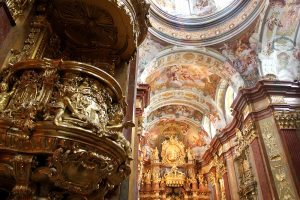 The top five architects of European Baroque – Beduzzi, Mattielli, Prandtauer, Rottmayr, Troger – thoroughly baroquified the medieval church. The place climaxed the art of glorifying God: the rule of St. Benedict.
The top five architects of European Baroque – Beduzzi, Mattielli, Prandtauer, Rottmayr, Troger – thoroughly baroquified the medieval church. The place climaxed the art of glorifying God: the rule of St. Benedict.
‘Where does the money come from?’ and ‘feudal riches, well well…’ crossed my mind as I marvelled at richly carved and gold plated pulpits, marble columns and delicate frescoes the size of a football field.
The Marble Hall
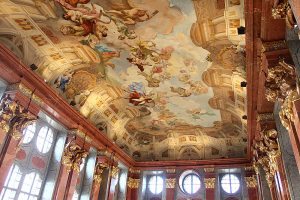 The Marble Hall was another place to dwarf even Schonbrunn Palace’s Grand Ballroom. Greek gods roaming the blue skies of baroque star painter Paul Troger to pay reference to Habsburg Emperor Charles VI dominated the representational room.
The Marble Hall was another place to dwarf even Schonbrunn Palace’s Grand Ballroom. Greek gods roaming the blue skies of baroque star painter Paul Troger to pay reference to Habsburg Emperor Charles VI dominated the representational room.
![]() My tip: As you cross the room keep your eyes fixed on the painted white columns above the door across. As you walk, the columns change in size, creating a dazzling shift in perspective.
My tip: As you cross the room keep your eyes fixed on the painted white columns above the door across. As you walk, the columns change in size, creating a dazzling shift in perspective.
The Museum
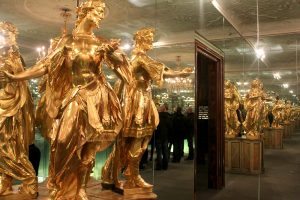 Unlike many monastery museums in Austria, this one was surprisingly fresh and well organised. As you walked through, you traced the life of St. Benedict, the founder of Melk Abbey. The development of the monastery itself and its role in society over the centuries unfolded well. What was more, you learned about the way of life of Benedictine monks, who had been living and working there for more than 900 years (quite a contrasting programme for most of us).
Unlike many monastery museums in Austria, this one was surprisingly fresh and well organised. As you walked through, you traced the life of St. Benedict, the founder of Melk Abbey. The development of the monastery itself and its role in society over the centuries unfolded well. What was more, you learned about the way of life of Benedictine monks, who had been living and working there for more than 900 years (quite a contrasting programme for most of us).
Modern design highlighted hundreds of years old objects. The most stunning room was entirely covered with mirrors, reflecting and multiplying four gold statues placed strategically in each corner (see photo).
Where Is Melk Abbey Exactly?
Location: Stift Melk
Abt-Berthold-Dietmayr-Strasse 1
A-3390 Melk
What Is The Best Way To Visit Melk Abbey From Vienna?
Melk Abbey makes a top cultural day trip from Vienna. Plus, you can combine it with a little Danube cruise and a wine tour.
1. Small Group Tour to Wachau Valley
 No more than eight travellers will join this boutique van tour to Wachau Valley. I have taken it in 2013 and thoroughly liked the individual setting, moving easily between wine tastings, walks in Duernstein, and cultural sightseeing.
No more than eight travellers will join this boutique van tour to Wachau Valley. I have taken it in 2013 and thoroughly liked the individual setting, moving easily between wine tastings, walks in Duernstein, and cultural sightseeing.
During the winter months you will tour Melk Abbey, while in the summer you will take a Danube boat ride from Spitz to Melk and will see the abbey from outside.
Find out more.
2. The Abbey by Bus And Boat
This tour helps you see as much as possible from Wachau Valley in a day, with Melk Abbey as the highlight. On a positive note, you won’t wreck your shoes from long walks as you will see most of the area’s castles and villages from the bus. The tour includes the entrance fee (EUR 12 for a guided tour) to the abbey. The tour there takes one hour, which is the minimum you should spend there. In the summer, the trip includes a really nice boat ride on the Danube. A good value for money tour if you are happy to accept the given itinerary.
Read more.
3. Visit Melk Abbey With Private Guide
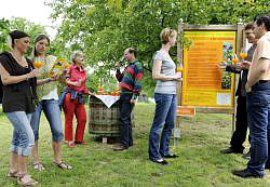 The most individual way for a day trip to Melk and Wachau Valley is going there with your own private guide and car. While Melk Abbey will be a highlight your guide will take you to amazing places such as Durnstein and a local Heuriger for some wine tasting. In the summer you can add a little Danube cruise, or ask to walk the apricot trail (photo). Your guide will take you around in a super convenient minivan. Pick up and drop off is directly from your hotel. Find out more.
The most individual way for a day trip to Melk and Wachau Valley is going there with your own private guide and car. While Melk Abbey will be a highlight your guide will take you to amazing places such as Durnstein and a local Heuriger for some wine tasting. In the summer you can add a little Danube cruise, or ask to walk the apricot trail (photo). Your guide will take you around in a super convenient minivan. Pick up and drop off is directly from your hotel. Find out more.
4. Getting To Melk On Your Own
For the fastest connection to Melk, take the Cityjet Express train from Wien Westbahnhof to Melk. In the mornings, the train departs about every hour and takes exactly one hour. From the train station, take a footpath up to the abbey. Between April and October, consider taking a boat ride downstream from Melk and Krems. You can later take a train from Krems back to Wien Franz Josefs-Bahnhof.
find out more about doing a guided Wachau Tour: Wine Tasting And Danube Biking
explore a small group minivan Wachau Valley Tour
find other Day Trips From Vienna: Salzburg, Bratislava, Wachau, Budapest, Burgenland
back to Vienna Unwrapped
